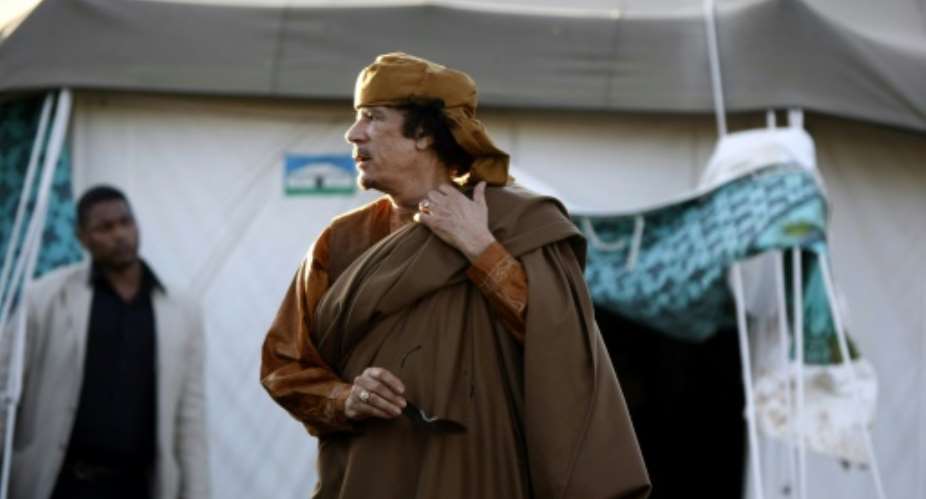Oil-rich Libya has been mired in chaos since dictator Moamer Kadhafi was ousted and killed in a popular uprising backed by a NATO air campaign a decade ago.
Its UN-recognised government is based in Tripoli, while eastern strongman Khalifa Haftar supports a parallel administration based in the east. A myriad of militias is also vying for control.
Here is a timeline of the Mediterranean country's descent into turmoil.
Kadhafi killed
Encouraged by Arab Spring uprisings in Tunisia and Egypt, demonstrations erupt in Libya in February 2011.
A coalition led by Washington, Paris and London lends its backing to an armed revolt.
 Demonstrations erupted in Libya in February 2011. By STR (AFP/File)
Demonstrations erupted in Libya in February 2011. By STR (AFP/File)
Kadhafi, in power for 42 years, flees the capital but is captured and killed on October 20.
Three days later, the rebel National Transitional Council (NTC) declares Libya "liberated".
In August 2012, the NTC hands over power to a transitional authority, the General National Congress (GNC).
Embassies targeted
US ambassador Chris Stevens and three American staff are killed in a September 11, 2012 attack on their consulate in Libya's second city, Benghazi. An Al-Qaeda-linked jihadist group is blamed.
A car bomb in April 2013 targets France's embassy in Tripoli, wounding two French guards.
Most foreign delegations withdraw.
Rival governments
Haftar launches an offensive in May 2014 against jihadist groups in Benghazi.
Several military officers from the east join his self-styled Libyan National Army.
 Eastern strongman Khalifa Haftar supports an administration based in the east. By - (AFP/File)
Eastern strongman Khalifa Haftar supports an administration based in the east. By - (AFP/File)
As nationalists and Islamists vie for power, legislative polls are held in June and a parliament is elected, dominated by anti-Islamists.
But Islamist-led militias contest the results and storm Tripoli in August, restoring the GNC to power.
The elected house, which has international recognition, takes refuge in the eastern city of Tobruk.
Thus, the country finds itself with two governments and two parliaments.
After months of negotiations and international pressure, lawmakers from the rival parliaments sign an accord in December 2015 to set up a Government of National Accord (GNA).
In March 2016, GNA chief Fayez al-Sarraj arrives in Tripoli to set up the new government, but Haftar's rival administration refuses to recognise its authority.
Haftar's offensives
Haftar announces the "total liberation" of Benghazi from jihadists in July 2017, after more than three years of fighting.
He is backed by neighbouring Egypt and the United Arab Emirates, later also forming links with Russia.
In January 2019, Haftar launches an offensive into oil-rich southern Libya. His forces seize the region's capital, Sebha, and one of the country's main oil fields.
In April, Haftar orders his troops to advance on Tripoli.
Foreign involvement
Russia is reported to have sent mercenaries in November 2019 to help Haftar's forces.
 Map showing the positions of forces fighting in Libya. By (AFP/File)
Map showing the positions of forces fighting in Libya. By (AFP/File)
A UN report in December accuses several countries of breaching a 2011 arms embargo by supplying both camps.
In January 2020, Turkey announces the deployment of troops to help the Tripoli government, opening the way to a series of battlefield breakthroughs for the GNA.
Government hits back
In early June, government forces say they have overrun Haftar's last western stronghold, Tarhuna, the launchpad of the abortive assault on Tripoli.
They start an operation to retake Sirte, a strategic crossroads between the east and west of the country.
In June 2020, Egyptian President Abdel Fattah al-Sisi threatens a "direct" intervention if the government forces advance on Sirte.
Ceasefire
 Libyan delegates at UN-led talks in Switzerland on February 5 chose Abdul Hamid Dbeibah as prime minister of a transitional unity government. By Handout (UNITED NATIONS/AFP/File)
Libyan delegates at UN-led talks in Switzerland on February 5 chose Abdul Hamid Dbeibah as prime minister of a transitional unity government. By Handout (UNITED NATIONS/AFP/File)
On October 23, the rival governments sign a "permanent" ceasefire agreement after five days of UN-hosted talks in Geneva.
The following month, both sides agree at UN-led talks to hold elections on December 24, 2021.
On February 5, Libyan delegates at UN-led talks in Switzerland chose Abdul Hamid Dbeibah as prime minister of a transitional unity government, along with a three-member presidency council, to steer the country through to the elections.





 We’ll protect state wealth from opaque deals – Prof Jane Naana
We’ll protect state wealth from opaque deals – Prof Jane Naana
 Mauritania president says running for second term in June polls
Mauritania president says running for second term in June polls
 I won't ever say I was a mere driver’s mate' — Prof. Opoku-Agyemang
I won't ever say I was a mere driver’s mate' — Prof. Opoku-Agyemang
 2024 polls: 'EC struggling to defend credibility'— Prof. Opoku-Agyemang
2024 polls: 'EC struggling to defend credibility'— Prof. Opoku-Agyemang
 Akufo-Addo gov't's 'greed, unbridled arrogance, unrestrained impunity, sheer dis...
Akufo-Addo gov't's 'greed, unbridled arrogance, unrestrained impunity, sheer dis...
 Election 2024: Ghana needs an urgent reset, a leadership that is inspiring – Ma...
Election 2024: Ghana needs an urgent reset, a leadership that is inspiring – Ma...
 Partner NDC to rollout a future of limitless prospects – Prof Jane Naana Opoku-A...
Partner NDC to rollout a future of limitless prospects – Prof Jane Naana Opoku-A...
 NPP will remain in gov’t till Jesus comes — Diana Asamoah
NPP will remain in gov’t till Jesus comes — Diana Asamoah
 Sunyani Technical University demands apology from former SRC president over sex-...
Sunyani Technical University demands apology from former SRC president over sex-...
 'Dumsor' was resolved by Mahama but ‘incompetent' Akufo-Addo has destroyed the g...
'Dumsor' was resolved by Mahama but ‘incompetent' Akufo-Addo has destroyed the g...
